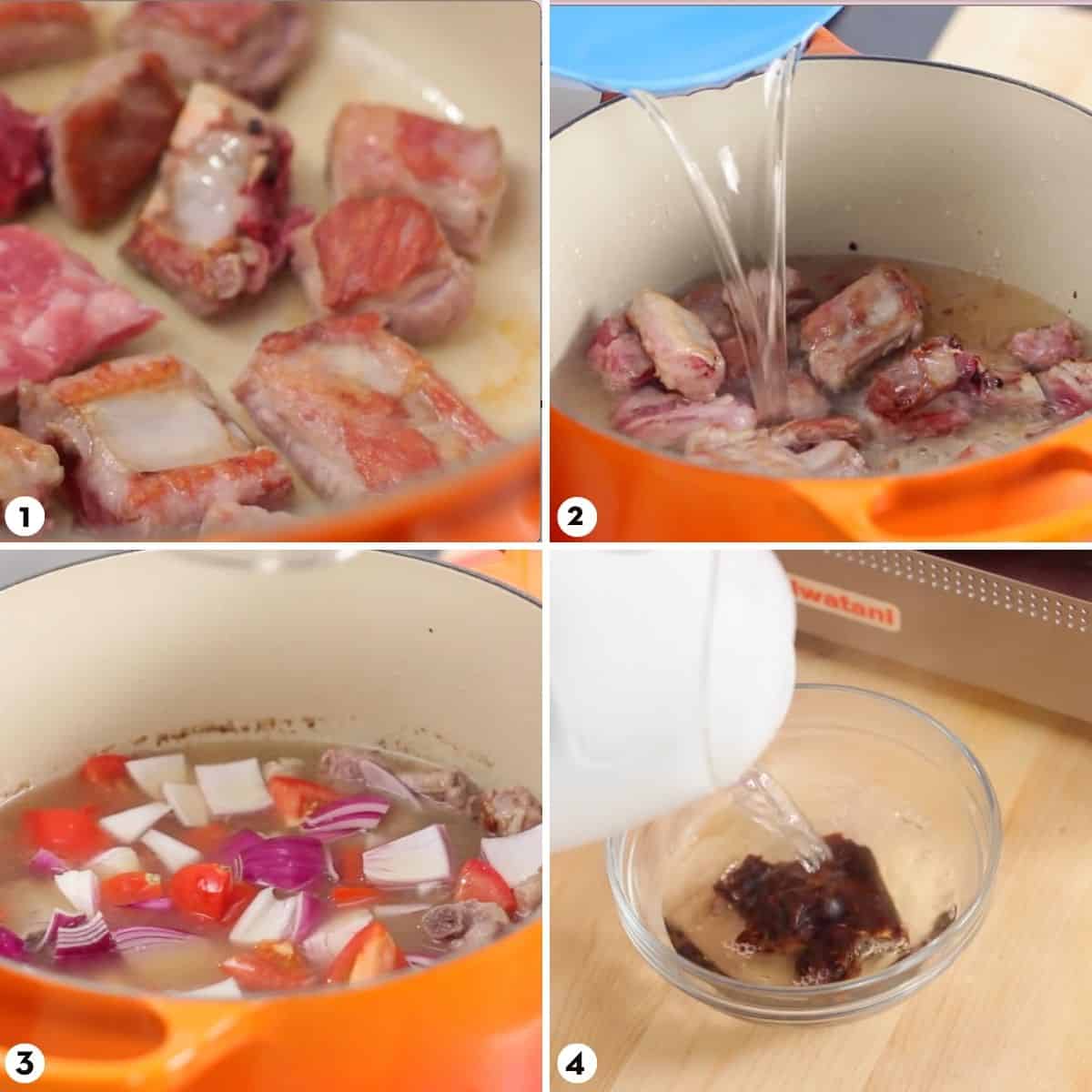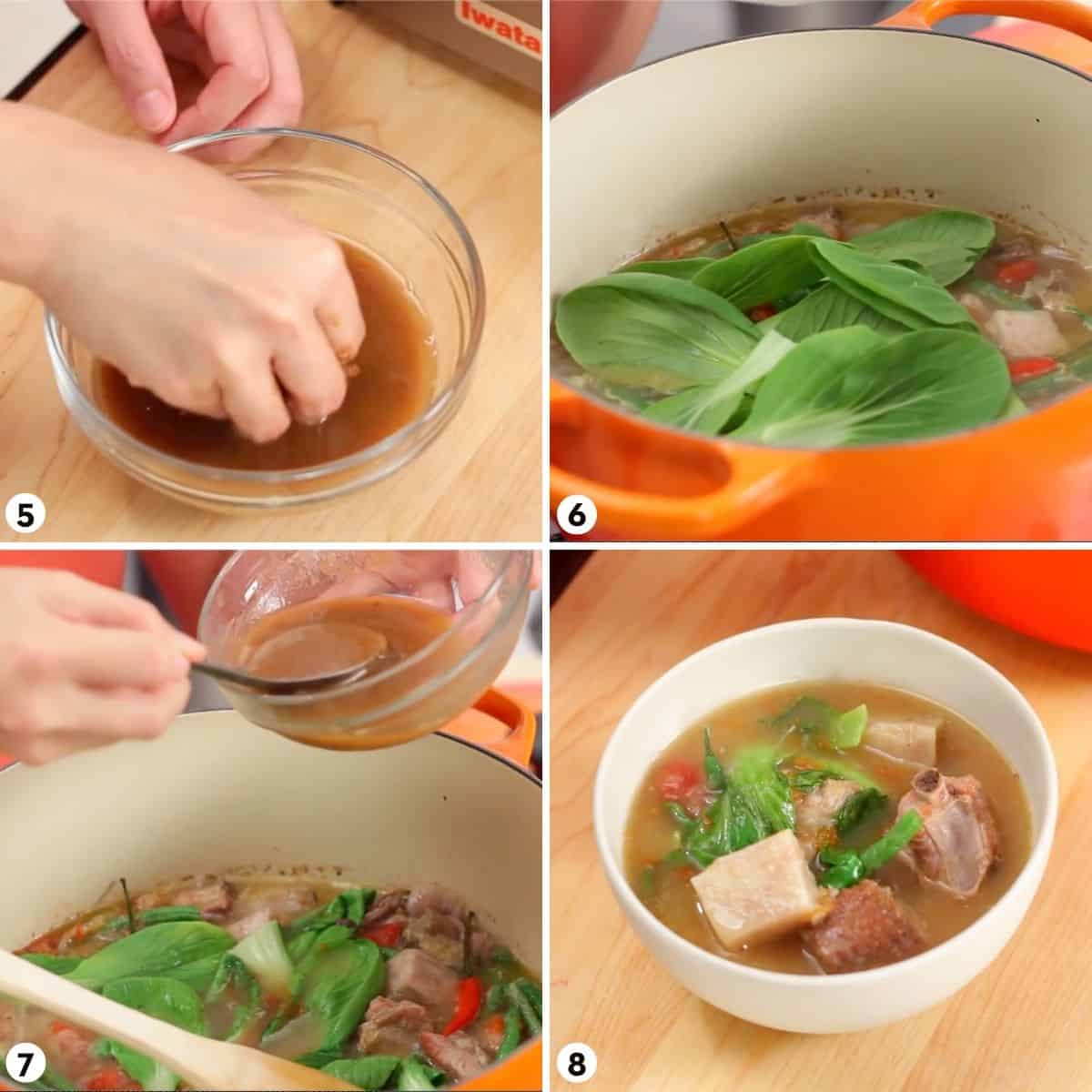I have gotten many requests for sinigang, and I am very happy about that because it's one of my favourite Filipino dishes. I remember the first time I had it I thought, "It's like a Filipino version of tom yum!"
Sinigang is a Filipino sour soup, owing its sour flavour from tamarind. With lots of veggies and hearty meat, this tart soup is both rich and refreshing, if that's even possible.
Nowadays, many people make sinigang using a powdered soup mix, but I make mine completely from scratch and you'll see in the video tutorial that it's really not any more difficult! Feel free to change up the protein if you don't eat pork. Change up the veggies, too, if you like!
Ingredients
- Pork spare ribs, chopped into small pieces. You can buy these ribs already chopped at most Asian butchers. If you like pork belly, you can replace some of the ribs with pork belly for a meatier and fattier soup. If you don't eat pork, other meats can also be used, but if using a boneless meat, you need to use chicken stock or pork stock instead of water to ensure good flavour.
- Salt
- Seedless tamarind pulp or premade tamarind paste. This is the a souring agent and is the most important ingredient in this soup! Store bought tamarind paste is fine, but if you start out with tamarind pulp which will get you even better flavour. In the video I show you how to make just enough for this recipe, but if you want to make tamarind paste in bulk, which is what I do, watch this DIY tamarind paste tutorial.
- Red onion
- Tomato
- Fish sauce
- Baby bok choy, water spinach or other greens that you like in soup
- Long beans (aka string beans) or green beans, cut into 1"-2" pieces
- Taro root, both larger or smaller roots will work, so choose whatever you prefer. Larger ones are a little starchier.
- Thai chilies, or another hot pepper.
How to Make Sinigang
Here's a brief look at the steps for making sinigang. Be sure to refer to the full written recipe and watch the full video tutorial below to ensure success!

Want to save this recipe?
- Salt the pork ribs and sear them in a large, heavy-bottomed pot until browned. You may need to do this in batches.
- Add all the pork back into the pot and add water to cover. Add fish sauce, bring to a boil, then turn it down to a simmer and cook for 20 minutes.
- Skim off the scum then add onion and tomatoes; simmer for another 45 minutes or until the meat is tender.
- Meanwhile,make the tamarind paste by placing the pulp in a bowl and cover with hot water; let sit until cool enough to handle.

- Squish the tamarind with your hand to release the pulp into the water then strain off all the fibers.
- Once the pork is tender, add the vegetables in the order in which they take to cook, starting with harder vegetables and ending with leafy greens first.
- Season the soup with most of the tamarind paste, then taste and adjust with more tamarind and fish sauce as needed.
- Enjoy with jasmine rice
Storing Leftovers
Sinigang is a great dish to make in advance because it keeps well, and tastes even better as it sits in the fridge and the flavours have a change to mingle. It will last at least a week in the fridge, but when reheating, be careful not to overcook the taro.
Watch The Full Video Tutorial!
All my recipes come with step-by-step video tutorials with extra tips not mentioned in the blog post, so make sure you watch the video below to ensure success - and if you enjoy the show, please consider subscribing to my YouTube channel. Thank you!

Filipino Sinigang with Pork Ribs
- Yield: 4 servings
Ingredients
- 1 ½ lb pork spare ribs, chopped into small pieces (see note)
- 1 generous pinch of salt
- 45g seedless tamarind pulp or 4-5 tablespoon tamarind paste
- ½ large red or yellow onion, roughly chopped
- 2 roma tomatoes, large dice
- 2 Tbsp fish sauce
- 3 heads baby bok choy, water spinach or other greens you like in soup
- 1 cup long beans or green beans, cut into 1"-2" pieces
- 2 cups taro root, large cubes
- Thai chilies, crushed just until broken
Note: You can buy chopped up spare ribs at Asian butchers. If you cannot find it, you can simply use a rack of ribs, separated into individual bones; it's just gonna be a bit harder to sear and to eat. You can also substitute other kinds of meat; however, if using boneless meat, you MUST use a good stock instead of water, otherwise your soup will be really weak in flavour and body.
Shop Ingredients & Kitchen Tools I Use
Want to save this recipe?
Instructions
- Salt the pork ribs. In a large heavy bottomed pot, add a little oil just to coat. Once oil is hot, add the ribs and sear until browned on both sides; do not crowd the pot, you will probably need to do this in a couple of batches.
- Once the pork is all seared, add them all back to the pot and add just enough water to cover the pork by about 1 cm. Add the fish sauce and simmer for about 15-20 minutes or until scum and foam has collected on top. Skim off the scum with a fine mesh strainer, then add onion and tomatoes, and simmer for another 45 minutes or until the pork is fork tender.
- Meanwhile, if using tamarind pulp, use this time to make tamarind paste. Place the pulp in a medium bowl, cover with off-the-boil water and let sit until cool enough to handle. Squish the tamarind with your hands until all pulp has been released into the water. Strain off all the fibers.
- Once the pork is fork tender, add taro cubes and chilies, and simmer for 7 minutes. Add the beans and cook for 2 more minutes, then add bok choy or any leafy greens you're using. Check that the taro is tender by piercing a fork through it and it should go through easily. Season the soup with most of the tamarind juice and then taste, adding more fish sauce and tamarind as needed (note: I used up all of my tamarind juice in the video). You shouldn't need any added sugar for this, but if the soup feels too sour, you can add a little sugar to balance.
- Serve with jasmine rice!





Camille says
Love this recipe. I’ve made it multiple times. Any tips if wanting to use instant pot??
Pailin Chongchitnant says
Awesome! Glad you liked it! To use the IP, cook only the pork and seasonings in under high pressure (I'd look up other recipes that use this pork ribs for timing) and then open it and cook the veggies in saute mode.
Jess says
Hi, why add the tamarind at the end? Is it better than adding it with the onions and tomatoes?
Pailin Chongchitnant says
You want to add once the water is no longer evaporating, otherwise you can't taste and adjust if you don't know how much water will remain at the end.
Teresa says
Is there a difference between sautéing the meat with the onions and tomatoes rather than searing them then adding water and onions and tomatoes? Anyway, I’ve always use your recipe since I’ve come across it. It’s so simple and yet packed with flavor. Thanks
Pailin Chongchitnant says
Glad you like it!! There is a difference. When you saute meats with veggies, because of the liquid from the veggies, the meat will not get as browned as searing. And browning is where the extra flavour comes from and why we sear in the first place. Good questions!
Hélène Deschamps says
Love this soup!!! I made it twice this week!!! Thank you for the recipe!!
Jessiejj says
Wonderful flavor. Easy steps! Thank you! My boyfriend lived it!
Roy says
Good to hear your bf lived after eating your cooking.
Alma says
Hello, are taros necessary? If i make do without them, does it make the soup much less delicious (for lack of better phrasing)?
Pailin Chongchitnant says
Nope, you can leave it out and it'll still be delicious.
Rocs says
I'm Filipino and this is my go-to recipe for pork sinigang. YUM!!
By the way, there's one step in the video that you forgot to include in the written recipe: the addition of fish sauce after searing the ribs. Would be fantastic if you made the correction. Thanks, Pai!
Jeffrey Albania says
Simple and Easy to follow and the result is very satisfying. Thanks for doing this.